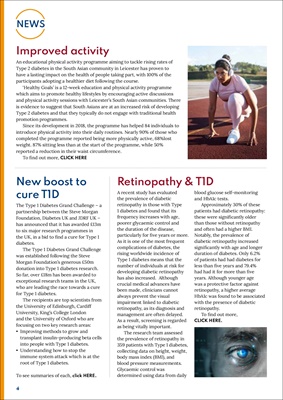
4
NEWS
Improved activity
An educational physical activity programme aiming to tackle rising rates of
Type 2 diabetes in the South Asian community in Leicester has proven to
have a lasting impact on the health of people taking part, with 100% of the
participants adopting a healthier diet following the course.
'Healthy Goals' is a 12-week education and physical activity programme
which aims to promote healthy lifestyles by encouraging active discussions
and physical activity sessions with Leicester's South Asian communities. There
is evidence to suggest that South Asians are at an increased risk of developing
Type 2 diabetes and that they typically do not engage with traditional health
promotion programmes.
Since its development in 2018, the programme has helped 84 individuals to
introduce physical activity into their daily routines. Nearly 90% of those who
completed the programme reported being more physically active, 68%lost
weight. 87% sitting less than at the start of the programme, while 50%
reported a reduction in their waist circumference.
To find out more, CLICK HERE
New boost to
cure T1D
The Type 1 Diabetes Grand Challenge - a
partnership between the Steve Morgan
Foundation, Diabetes UK and JDRF UK -
has announced that it has awarded £13m
to six major research programmes in
the UK, in a bid to find a cure for Type 1
diabetes.
The Type 1 Diabetes Grand Challenge
was established following the Steve
Morgan Foundation's generous £50m
donation into Type 1 diabetes research.
So far, over £18m has been awarded to
exceptional research teams in the UK,
who are leading the race towards a cure
for Type 1 diabetes.
The recipients are top scientists from
the University of Edinburgh, Cardiff
University, King's College London
and the University of Oxford who are
focusing on two key research areas:
• Improving methods to grow and
transplant insulin-producing beta cells
into people with Type 1 diabetes.
• Understanding how to stop the
immune system attack which is at the
root of Type 1 diabetes.
To see summaries of each, click HERE.
Retinopathy & T1D
A recent study has evaluated
the prevalence of diabetic
retinopathy in those with Type
1 diabetes and found that its
frequency increases with age,
poorer glycaemic control and
the duration of the disease,
particularly for five years or more.
As it is one of the most frequent
complications of diabetes, the
rising worldwide incidence of
Type 1 diabetes means that the
number of individuals at risk for
developing diabetic retinopathy
has also increased. Although
crucial medical advances have
been made, clinicians cannot
always prevent the visual
impairment linked to diabetic
retinopathy, as its diagnosis and
management are often delayed.
As a result, screening is regarded
as being vitally important.
The research team assessed
the prevalence of retinopathy in
359 patients with Type 1 diabetes,
collecting data on height, weight,
body mass index (BMI), and
blood pressure measurements.
Glycaemic control was
determined using data from daily
blood glucose self-monitoring
and HbA1c tests.
Approximately 30% of these
patients had diabetic retinopathy:
these were significantly older
than those without retinopathy
and often had a higher BMI.
Notably, the prevalence of
diabetic retinopathy increased
significantly with age and longer
duration of diabetes. Only 6.2%
of patients had had diabetes for
less than five years and 79.4%
had had it for more than five
years. Although younger age
was a protective factor against
retinopathy, a higher average
HbA1c was found to be associated
with the presence of diabetic
retinopathy.
To find out more,
CLICK HERE.